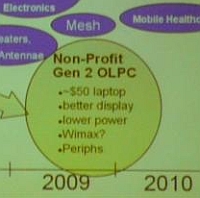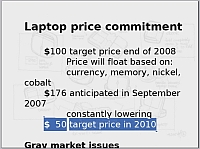
Notebooks under the Massachusetts Institute of Technology (MIT) advocated "One Laptop Per Child" (OLPC) program are in a strong position to be the hottest PC for emerging markets and prices will shrink to US$50 in 2009, said Mary Lou Jepsen, the founding chief technology officer (CTO) of the program.I say "attempted" because the very next day, Ken Fisher wrote in Ars Technica that he contacted Race Point Group, OLPC's new public relations group and was told:
Jepsen was misquoted and the DigiTimes story is "full of errors." A spokesperson told Ars Technica that OLPC is in discussions with several governments about their interest in the OLPC XO laptop but that it is simply not possible to estimate shipping volume in 2008, let alone in 2009.Not to be upstaged, just yesterday Digitimes came back with an apparent slap at Ken and Ars Technica with its in-your-face "US$50 OLPC a PR KO", where it showed photos of Mary Lou Jepsen's slides talking about price and production projections with the gleeful:That said, they did confirm that the price is expected to drop in 2009, as a combination of sales numbers, potential design changes, and component costs are factored in after the project has become firmly established. However, $50 has never been discussed as a target, and OLPC publicly has only focused on the possibility of getting the laptop down to approximately $100 in cost.
On July 4, Jepsen gave a keynote presentation at the International Display Manufacturing Conference (IDMC) 2007 in Taipei. During the presentation a roadmap was shown which indicted that OLPC has plans for a second-generation OLPC notebook in 2009.Before Digitimes starts to dance, or we question who is Race Point Group, since the last time we checked, W2 was OLPC's pro bono PR team, I'd like to point out that the $50 price point projection is not new for One Laptop Per Child or the readers of OLPC News.Based on the roadmap, features of the design do seem to suggest a notebook in the US$50 range, with an improved display, lower power requirements and perhaps WiMAX seen as key points of the next-generation product.
Why there is a discrepancy between statements made by Race Point Group and OLPC's roadmap is unclear, as both Jepsen and Race Point Group have not responded to Digitimes' requests for clarification. However, once the OLPC's plans become more clear, Digitimes will provide an update.
If we go back all the way to Nicholas Negroponte's February 2006 TED speech, transcribed on OLPC Talks, we find his first mention of a $50 dollar OLPC XO target in 2010, but it's the May 2006 speech at WCIT, where he fully articulates his price target:
Very quickly, people always ask: "Is it really a hundred dollars?" The answer is - It will be below a hundred dollars. The hundred dollar price is the 2008 price. It will probably launch at one-hundred thirty-five. The target is fifty dollars.And in September of 2006, Nicholas Negroponte was reported by ZDnet as saying
The anticipated price for the 2007 model is $138, going to down to $100 by the end of 2008 and getting to $50 in 2010Better yet, on May 27th, Martin Woodhouse proposed a $50 dollar One Laptop Per Child eBook reader on OLPC News.
But best of all, Nicholas Negroponte and Walter Bender's World Bank presentation on May 31, has slide #48 showing a irrefutable $50 laptop price projection (highlight mine):
So what is the $50 dollar lesson learned from this experience? Check with OLPC News and OLPC Talks before you go mouthing off about One Laptop Per Child. The answers you seek are already known.




Digitimes price point backpedaling already, eh?
"10 Jul 2007: A July 5 article about the OLPC project has been reworded to use "may" instead of "will" in certain places."
http://digitimes.com/Backgrounders/Features/sitenote.asp
Did you know WiMax was planned for XO-2? I asked Nicholas Negroponte about WiMax in May 2006 when I filmed at the http://charbax.com/category/wcit2006/ and he told me that WiMax was overrated.
I guess it'll be both 802.16e and WiFi mesh in one, since WiFi Mesh will always be best for ad-hoc collaboration in forming local wireless networks. But for 802.16e to become usable, the WiMax industry needs to focus on the more usefull low frequency bands, 700mhz would be the best, the band currently still occupied by analog terrestrial TV, that one should become WiMax, this way the industry will manufacture cheap long range, wall-penetrating, stable WiMax chips to use those frequencies and XO-2 could then include it. A less optimizable WiMax usb-key could be added to the XO-1.
OLPC will hit $100 as soon as it is mass manufactured at the rate of a million a month, thus by the end of 2008 we all hope. Then by the end of 2009 the price will point below $100 and approch the $50 price point.
The whole point of the OLPC hardware is that it is optimizable, low power, low complexity thus low cost. It's basically like any piece of consumer electronics. At the beginning, calculators were expensive, but it didn't take a long time for everyone to be able to buy calculators for less than $10 a piece.
The price is not $100; the price is not $176; the price is unknown, and so is the TOC.
It's predicted here that Negroponte will not succeed. His offer is devoid of any educational value, and he doesn't have enough corrupt governments to bribe/coerce to make the OLPC Project viable.
Time will tell.
Price of components, every detail of the development and bugfixing, everything about the OLPC is available at http://wiki.laptop.org unlike Intel who keeps everything about their Classmate secret.
As I've mentioned in the past, the manufactured cost of the laptop itself is only applicable if you were to buy one laptop for yourself. I'd be more interested in the purchase price of the commercial version from Quanta. Maybe $300? (once you include shipping and wholesale/retail markups).
The whole "$100 Laptop" theme is just marketing hype.
The more critical pricing is purchase and implementation of 250,000 plus laptops and associated costs of deployment and infrastructure to use them in schools.
Its not a $50 or $100 or even $170 laptop, its a $50 million dollar (plus?) education system, paid for by Governments.
I think more announcements of a $50 XO computer could effectively stop the purchase plans of project countries.
Governments would decide to wait for the lower price so as not to be questioned why they paid $176 for a $50 product. That would put the whole OLPC timeline in serious jeopardy. Quanta is already lowering its production estimates.
See http://www.digitimes.com/systems/a20070709PB207.html
"Quanta likely to ship less than one million OLPCs... Quanta has begun placing orders for needed parts and components with downstream suppliers but with the ordered quantities falling far short of expectations"
"I think more announcements of a $50 XO computer could effectively stop the purchase plans of project countries."
The Osborn effect did kill the Osborn 2, it might kill the OLPC.
http://en.wikipedia.org/wiki/Osborne_effect
It is like the old joke. Customer wants to buy shoes. Sales person warns shoes will be stiff and uncomfortable in the first two weeks. Customer anounces to buy them in two weeks.
I dare to predict that the current OLPC XO will be less than $10 in 2020. But only if they are launched now and produced in the 10s of millions. So any price quote of $50 in three years is pure futurology.
The obvious solution for countries is to order them for flexible prices: Pay current prices for delivery now, and then current prices for later batches. But again, this is why economists fear derflation more than inflation: even modest deflation can kill an economy.
Winter
Hi, I am surprised why you are still using the US dollar in your all references. Haven't you noticed how much the US dollar has dropped compared to other currencies such as the euro, pound and yen? The dramatic drop of the US dollar should be taken into account, no? What was supposed to be a $100 laptop in 2003 would now be a $ 130 or 140 laptop, compared to the euro. Or am I wrong here?
You forgot the renminbi in your mix of currencies. Since the XO is to be manufactured in China the valuation of Chinese currency will loom large in any price calculations.
The Chinese have held the exchange rate of the renminbi below market rates making dollar-, yen-, euro-, pound-denominated prices of the XO artificially low.
That may change, the U.S. has pressured China to revalue its currency upward which the Chinese have resisted doing. If the Chinese do bring their exchange rate closer to market valuation the result will be Chinese exports becoming more expensive among which would be the XO.
Depending on what exchange rates do it might be impossible to hold the line at $170 or 21,165 Niaras. There are ways to offset such fluctuations but they carry their own, additional costs.
Fortunately the free market is capable of sorting out such complexities.
how do i buy a OLPC $100 laptop?
Good afternoon!
Our company is engaged in delivery of the trading equipment and mobile technics in Russia.
We were interested with your phones Nokia, and laptops. We would like to receive samples of your phones and laptops on testing. After that copies last testing. Then we will generate the order!
-
Yours faithfully,
Vladimir
icq: 290853326
mob: 89139996080
Company Valuter
http://www.valuter.ru